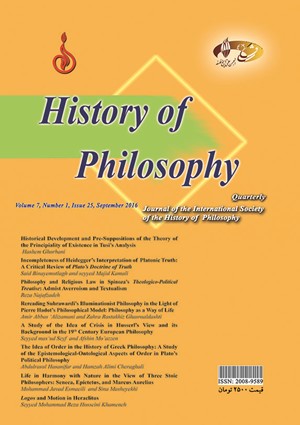-
-
List of Articles
-
Open Access Article
1 - foreword
Hossein Kalbasi Ashtari -
Open Access Article
2 - Historical Development and Pre-Suppositions of the Theory of the Principiality of Existence in Tusi’s Analysis
Hashem Ghorbani -
Open Access Article
3 - Incompleteness of Heidegger’s Interpretation of Platonic Truth: A Critical Review of Plato’s Doctrine of Truth
Said Binayemotlagh seyyed Majid Kamali -
Open Access Article
4 - Philosophy and Religious law in Spinoza’s Theologico-Political Treatise: Admist Averroism and Textualism
Reza Najafzadeh -
Open Access Article
5 - Rereading Suhrawardi’s Illuminationist Philosophy in the Light of Pierre Hadot’s Philosophical Model: Philosophy as a Way of Life
Amir Abbas ‘Alizamani Zahra Rastakhiz Ghasroaldashti -
Open Access Article
6 - A Study of the Idea of Crisis in Husserl’s View and its Background in the 19th Century European Philosophy
Seyyed mas‘ud Seyf Afshin Mo’azzen -
Open Access Article
7 - The Idea of Order in the History of Greek Philosophy: A Study of the Epistemological-Ontological Aspects of Order in Plato’s Political Philosophy
Abdulrasul Hasanifar Hamzah Alimi Cheraghali -
Open Access Article
8 - Life in Harmony with Nature in the View of Three Stoic Philosophers: Seneca, Epictetus, and Marcus Aurelius
Mohammad Javad Esmaeili Sina Masheyekhi -
Open Access Article
9 - Logos and Motion in Heraclitus
Seyyed Mohammad Reza Hosseini Khameneh Seyyed Mohammad Reza Hosseini Khameneh
-
The rights to this website are owned by the Raimag Press Management System.
Copyright © 2017-2026







